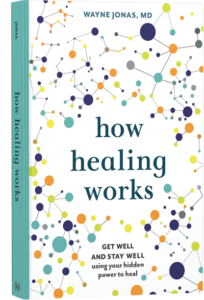If your doctor, family, or friends tell you that you seem depressed, they might be right. Pain and depression often go hand in hand, with pain both a symptom and a cause of depression. That doesn’t mean the pain you feel isn’t real, or that it’s “all in your head.”
In fact, headaches, body aches, and back pain are all symptoms of possible depression. So don’t let anyone minimize the pain you’re feeling. While there’s a large emotional component to pain that the medical profession might separate out as depression or anxiety, it doesn’t matter if the pain is physical or emotional; it’s the cross-link that’s real and it leads to a real impairment. In fact, true remission only occurs when you treat both the emotional and physical symptoms of depression.
That’s why I consider it so important when I see a patient with pain to assess her as a whole person – not just focusing on her pain.
Integrative Health Approaches
It is estimated that, when combined, pharmaceutical and behavioral interventions are effective in treating 60%-70% of people with depression, and much of this effect is due to simply getting treatment (i.e., the placebo effect). Additionally, pharmaceutical interventions can sometimes produce adverse effects and cannot be taken by certain patients (such as pregnant women). Integrating the use of evidence-based complementary interventions provides additional options for patients seeking non-drug approaches or for whom conventional forms of treatment do not work or are not wanted.
1. Light Therapy
In light therapy, you sit in front of a lamp (usually referred to as a light box) that emits light that is similar to natural sunlight. Light therapy is typically used with people who suffer from seasonal affective disorder (sometimes called winter blues or SAD) but may also be useful for clinical depression. Light emitted from the lamp affects chemicals in the brain linked to mood and sleep.
Evidence:
- A systematic review and meta-analysis (summary of studies) of the use of light therapy for patients with non-seasonal depression found that not only does light therapy have minimal side effects, but patients reported significant improvement in depressive symptoms.
- A study looking at the impact of light therapy on sleep and depression in older adults in long-term care homes found that there was a significant improvement in symptoms of depression among the study’s participants.
2. Exercise
Exercise has been shown to improve cognition, mood, emotional regulation, and motor function. The act of exercising can also increase social interaction (if done with others) and self-efficacy. The Mayo Clinic (and other organizations) support the use of exercise for symptom management among people with depression.
Evidence:
- A systematic review of randomized trials of exercise programs found that moderate, supervised aerobic activity three times a week for nine weeks improved depressive symptoms.
- A meta-analysis of randomized control trials with a total of 977 participants found that physical exercise is an effective modality for treating depression and is a useful adjunct to pharmaceutical interventions.
3. Yoga
Numerous studies attest to the benefits of yoga, a centuries-old mind-body practice, on a wide range of health-related conditions—particularly stress, mental health (including depression), and pain management.
Evidence:
- A randomized control study including 38 adults with mild to moderate depression found that an eight-week hatha yoga intervention clinically reduced depression symptoms.
- A systematic review of randomized control trials looking at yoga interventions for depression found that yoga improved depressive symptoms as much as taking an antidepressant drug.
- A twelve-week mindfulness-based yoga intervention for women with depression found that in comparison to those who participated in a walking group, those in the yoga group reported significantly lower levels of rumination (a frequent symptom of depression).
4. Mindfulness Meditation
Meditation is a practice that involves consciously exerting control over breathing and attending nonjudgmentally to the present moment. It produces multiple physiological and chemical effects such as decreased heart rate, blood pressure, and cortisol (stress hormone) levels.
Evidence:
- A meta-analysis of mindfulness-based approaches found they significantly reduce depressive symptoms and concluded that they are a promising approach for treating people suffering from clinical depression.
- A meta-analysis and systematic review looking at mindfulness-based cognitive therapy for depression found that those who had had three or more episodes of depression saw a significant reduction in recurrence of episodes.
5. Acupuncture
Acupuncture is a practice in which a trained specialist called an acupuncturist stimulates specific points on the skin called acupoints, usually with a needle. Stimulating acupoints increases the release of chemicals like endorphins (naturally-produced pain reducers) in the body and brain. These chemicals may directly impact how a person experiences pain.
Evidence:
- A meta-analysis of the use of acupuncture in conjunction with antidepressants for treating depression found that the combination was more effective than the use of antidepressants alone.
- A randomized, single-blind, placebo-controlled study looked at the impact of a twelve-week acupuncture intervention on the quality of life of patients with depression. The study found that those in the acupuncture group had significant improvement in eight quality of life domains including physical function, pain, energy, social and emotional function, and mental health.
6. Music Therapy
Music therapy is a well-recognized clinical intervention that uses music within a therapeutic process to assist the patient in identifying and dealing with social, cognitive, emotional, or physical concerns.
Evidence:
- A recent meta-analysis, published in the Cochrane Database, of systematic reviews found that music therapy in conjunction with conventional treatments improved depression symptoms and is more effective than only using conventional treatments alone.
- A systematic review and meta‐analysis of randomized, controlled trials looking at the impact of music therapy on elderly patients found that music therapy improved elderly patients’ depression symptoms.
7. Art Therapy
Art therapy is a form of clinical intervention that uses art as the primary mode of expression and communication. The art therapist uses creativity to help achieve personal and treatment-related goals. The patient uses and makes art to convey their feelings at that moment or relating to an experience or past situation. When people are experiencing intense, complex, or confusing emotions, the use of art in a therapeutic setting can help them learn about, manage, and communicate their feelings in ways that language cannot always accomplish. You do not have to be a talented or experienced artist to enjoy the benefits of art therapy.
Evidence:
- A meta-analysis looking at the impact of art therapy on breast cancer patients experiencing depression, anxiety, and fatigue found that those who participated in art therapy interventions had reductions in all three symptoms.
- A randomized control trial evaluating a manually-based art therapy program including 79 adults suffering from moderate to severe depression found that by the end of the study, patients had significant improvements.
8. Herbs and Supplements
Herbs and supplements involve taking a plant or pill, usually orally, to either maintain or improve an individual’s health. The most commonly used herbs and supplements used to treat depression are:
- John’s wort
- Saffron
- Omega-3 fatty acid (fish oil)
- MSM (Methylsulfonylmethane)
- 5-HT (5-hydroxytryptophan)
- SAMe (S-adenosyl methionine)
Understanding Complementary and Integrative Approaches
Conventional therapies work for depression and your doctor or primary care provider will most likely recommend or offer you those treatments first. Usually, you will be offered medications, although, current evidence shows that non-drug approaches like cognitive behavioral therapy (CBT) work just as well with fewer side effects. However, your insurance may not cover CBT. If the conventional approaches work and are satisfactory for you, then nothing further may be needed. If they are only partially effective, produce side effects that are unacceptable, or if you prefer a deeper, more comprehensive self-care approach to depression, consider integrative approaches. Many complementary and integrative approaches are safe and effective. For more information visit the National Center for Complementary and Integrative Health at the National Institutes of Health.
Talk To Your Doctor to Integrate These Practices
Always let your medical providers know what treatments you are using to improve your health. Never change your medications without consulting your providers. If your doctor does not know about or offer some of the complementary and integrative practices described in this pocket guide, give him or her a copy and ask if you can work with him or her to integrate them alongside the conventional treatment. In this way, you are both building a more holistic healthcare process for healing a chronic illness.
 Take Your Health Into Your Own Hands
Take Your Health Into Your Own Hands
Drawing on 40 years of research and patient care, Dr. Wayne Jonas explains how 80 percent of healing occurs organically and how to activate the healing process.
